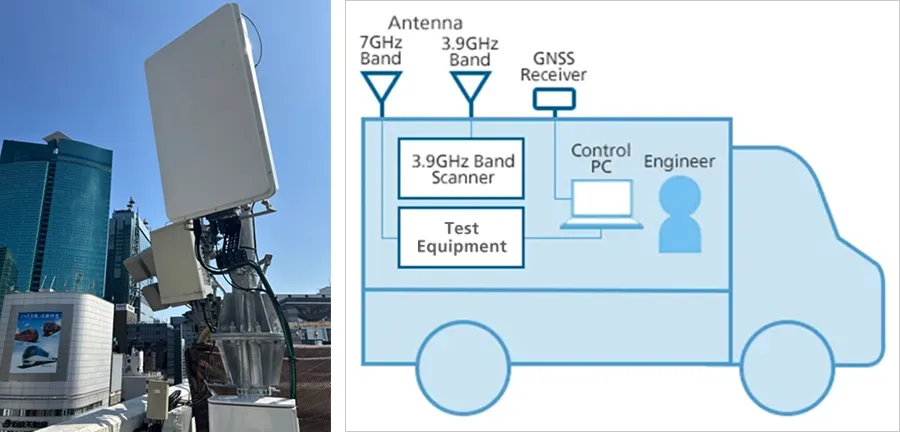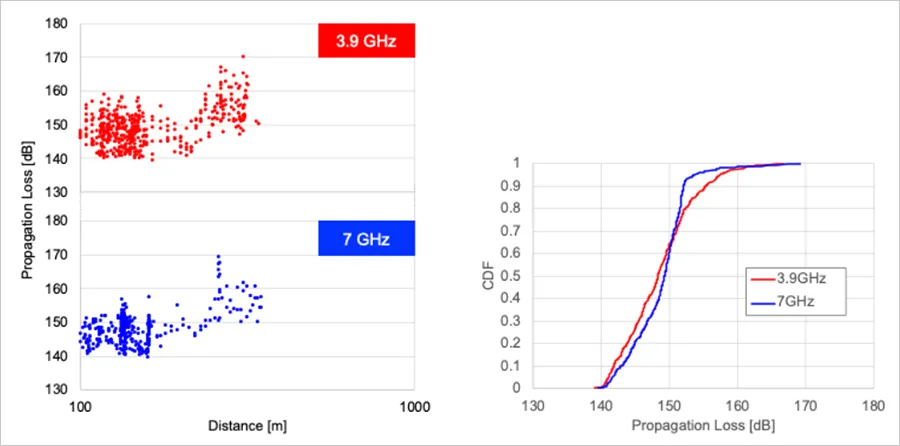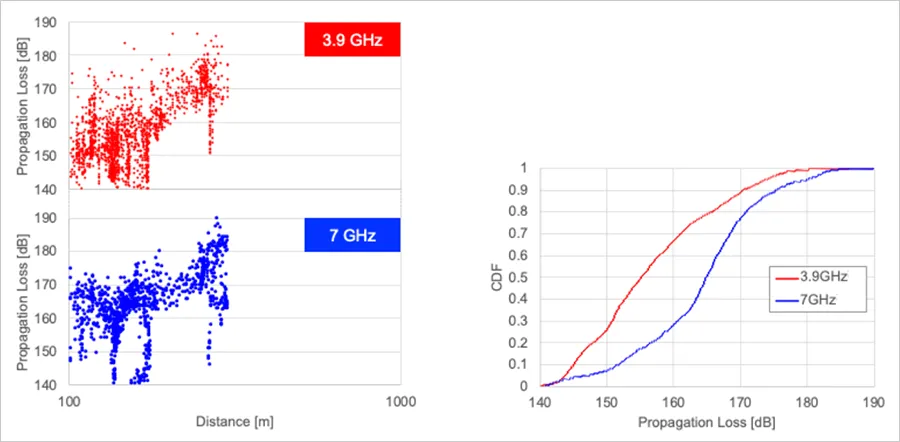SoftBank verifies wide-area coverage and high-quality communication using the 7GHz band
in urban environments
November 19, 2025
SoftBank Corp.
SoftBank Corp. (“SoftBank”) announced it successfully demonstrated the effectiveness of centimeter-wave spectrum*1 in the 7GHz band—which is under consideration as a frequency band for 6G—for wide-area coverage and stable communication quality in urban environments. The outdoor verification test, conducted in cooperation with Nokia, has been underway since June 2025*2. In this trial, SoftBank installed three experimental base stations supporting Massive MIMO in Tokyo’s Ginza district and confirmed that the 7GHz band enables both wide-area coverage and high-quality communication performance, even in dense urban environments.
As various AI-driven services become increasingly widespread, mobile data traffic is expected to surge dramatically. To support this AI-native society, future 6G networks will need to deliver both high-capacity data transmission and extensive coverage. The results of this experiment indicate that the 7GHz band can meet these requirements and is effective for urban deployment.
Overview and Results of the Verification Test
SoftBank obtained an experimental license for the 7GHz band and conducted outdoor verification in Tokyo’s Ginza area using Nokia’s base stations and test equipment. By installing three 7GHz base stations supporting Massive MIMO alongside commercial 3.9GHz 5G base stations, SoftBank evaluated the continuity of coverage, communication quality, and radiowave propagation characteristics.

Installation image of 7GHz experimental base stations / Overview of measurement vehicle used for field evaluation
Evaluation of area coverage and communication quality
Using a measurement vehicle, SoftBank measured the received signal power (RSRP*3) and communication quality within and around the target area (Figures 1 and 2). Strong received signal power was observed in line-of-sight areas such as main streets, while successful signal reception was also achieved in non-line-of-sight areas such as narrow alleys. These results confirmed that wide-area coverage can be achieved using the 7GHz band. Statistical analysis of the measured SINR (Signal to Interference plus Noise Ratio*4), an indicator of communication quality, showed values of 0dB or higher across all areas, confirming stable connectivity. The median SINR was 5.9dB, indicating that the entire area was covered with good communication quality. This result is attributable to the radiowave propagation characteristics of the 7GHz band—while diffraction into non-line-of-sight areas is limited, interference between adjacent base stations is less likely to occur, resulting in stable communication quality with minimal degradation.

Figure 1: Measurement results of 7GHz signal received power (the closer to green, the stronger the signal received power)

Figure 2: Measurement results of 7GHz SINR (the closer to green, the better the communication quality)
Evaluation of radiowave propagation characteristics
Based on the received signal power data collected from terminals at various distances from each base station, SoftBank also evaluated the radiowave propagation loss (the degree of signal attenuation) for both line-of-sight and non-line-of-sight environments. As shown in Figure 3, in line-of-sight areas, the radiowave propagation loss of the 7GHz band was nearly identical to that of 3.9GHz, with a median difference of less than 1dB. Although theoretical models predict that 7GHz signals should experience about 6dB higher loss, actual measurements showed smaller differences—likely due to signal reflections from surrounding buildings that helped maintain coverage.

Figure 3: Radiowave propagation characteristics in line-of-sight conditions (left: radiowave propagation loss versus distance, right: cumulative distribution)
On the other hand, as shown in Figure 4, the radiowave propagation loss of the 7GHz band in non-line-of-sight areas was generally greater than that of the 3.9GHz band, with a median difference of approximately 10dB. This difference is consistent with estimates based on typical non-line-of-sight radiowave propagation models and is believed to be due to differences in diffraction characteristics and reflection properties of building exteriors across the frequency bands.

Figure 4: Radiowave propagation characteristics in non-line-of-sight conditions (left: radiowave propagation loss versus distance, right: cumulative distribution)
Overall, the experiment demonstrated that 7GHz signals can provide wide-area coverage with high-quality connections when deployed as high-power macro base stations in urban commercial districts.
Dr. Akihiro Nakao, Professor at the Graduate School of Engineering, The University of Tokyo, and Co-Chairman of XG Mobile Promotion Forum (XGMF), commented:
“This evaluation serves as highly valuable evidence from Japan demonstrating the effectiveness of 6G network design using the 7GHz band. Building on the insights gained from this verification, we will continue to promote the formation of a global 7GHz band ecosystem and its social implementation through co-creation among industry, academia, government, and international partners.”
- [Notes]
-
- *1
Centimeter waves are radio waves with wavelengths of 1–10 cm (frequencies between 3–30 GHz). The 7–24 GHz range, defined as FR3 (Frequency Range 3) in 3GPP, is expected to be one of the new frequency ranges for 6G.
- *2
- *3
RSRP (Reference Signal Received Power) indicates the signal strength in a mobile network, measured in dBm (the closer to 0, the stronger the signal).
- *4
SINR (Signal to Interference plus Noise Ratio) expresses the ratio of signal power to interference and noise, measured in dB (higher values indicate more stable and faster communications).
- *1
- SoftBank, the SoftBank name and logo are registered trademarks or trademarks of SoftBank Group Corp. in Japan and other countries.
- Other company, product and service names in this press release are registered trademarks or trademarks of the respective companies.
- About the SoftBank Research Institute of Advanced Technology
-
Guided by its mission to implement new technologies into society, SoftBank Corp.’s Research Institute of Advanced Technology promotes R&D and business creation for advanced technologies that support next-generation social infrastructure, including AI-RAN and Beyond 5G/6G, as well as telecommunications, AI, computing, quantum technologies, and technologies in the space and energy sectors. Through industry-academia collaboration and joint research with universities, research institutions and partner companies in Japan and abroad, the SoftBank Research Institute of Advanced Technology is contributing to the creation of global businesses and a sustainable society. For more details, please visit the official website.